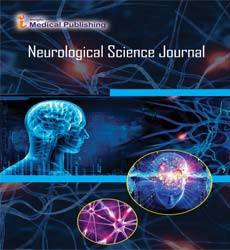Biochemistry of Nerve Transmission in Nerve Cell Action Potentials and Synaptic Transmission
Cheol Lars*
Department of Neurology, University of Toronto, Toronto, Canada
- *Corresponding Author:
- Cheol Lars
Department of Neurology,
University of Toronto,
Toronto,
Canada,
E-mail: Lars.Cheol@581.ca
Received Date: October 04, 2021; Accepted Date:October 18, 2021; Published Date: October 25, 2021
Citation:Lars C (2021) Biochemistry of Nerve Transmission in Nerve Cell Action Potentials and Synaptic Transmission. Neurol. Sci. Vol.5 No.5: e004
Editorial Note
The transmission of an efferent sign from the CNS to an objective tissue or an afferent sign from a fringe tissue back to the CNS happens because of the engendering of activity possibilities along a nerve cell. Nerve cells are volatile cells and they can react to different boosts like electrical, compound, or mechanical. At the point when the excitation occasion is spread along the nerve cell film it is alluded to as a nerve motivation or all the more regularly as an activity potential. At the point when a nerve cell ends on another it does as such at a specific design called a neural connection. Synaptic transmission alludes to the engendering of nerve driving forces (activity possibilities) starting with one nerve cell then onto the next. The neurotransmitter is an intersection at which the axon of the presynaptic neuron ends at some area upon the postsynaptic neuron.
The finish of a presynaptic axon, where it is compared to the postsynaptic neuron, is developed and frames a design known as the terminal button. An axon can make contact anyplace along the subsequent neuron: on the dendrites (an axodendritic neurotransmitter), the cbeolld y (an axosomatic neural connection) or the axons (an axoaxonal neurotransmitter).
Activity possibilities ea rthe consequence of layer depolarization whichi s achieved by an adjustment oft he appropriation of particles across the film. Contrasts in particle fixations on one or the other side of a layer bring about an electrical charge differential across the film which is alluded to as an electrochemical potential. Changes in particle fixations on one or the other side of a film bring about depolarization of the layer. When a piece of a film is depolarized, the particle inclinations should be gotten back to the "resting" express, an interaction alluded to as repolarization. The development of particles across the layer is the capacity of proteins and protein edifices named particle channels. Since nerve transmission includes changes in voltage (charge) across the plasma layer, these particle channels react to the voltage changes and are, thusly, alluded to as voltage-gated particle channels.
Nerve motivations are communicated starting with one neuron then onto the next, or from a neuron to an objective tissue cell, at neurotransmitters by the arrival of synapses. As examined exhaustively all through this page, synapses can be little synthetics, like amino acids or amino corrosive subordinates, or they can be lipids, for example, the endocannabinoid, anandamide. As a nerve drive, or activity potential, arrives at the finish of a presynaptic axon, atoms of synapse are delivered into the synaptic space. The arrival of synapse includes the cycles of exocytosis.
At the point when an activity potential reaches the presynaptic terminal the layer depolarization brings about the launch of voltage-gated Ca2+ channels. The convergence of Ca2+ particles actuates the layers of synapse secretory vesicles to intertwine with the plasma film permitting the substance to be delivered into the synaptic split.
The opening of voltage-gated K+ channels happens much more slow than for the Na+ channels and they are not completely open until the Na+ channels have re-shut. The launch of the K+ channels permits K+ to leave the phone which brings the net charge inside the phone back to the refreshed state potential. The launch of the K+ channels, following conclusion of the Na+ channels, addresses the repolarization stage and finishes the activity potential.
Open Access Journals
- Aquaculture & Veterinary Science
- Chemistry & Chemical Sciences
- Clinical Sciences
- Engineering
- General Science
- Genetics & Molecular Biology
- Health Care & Nursing
- Immunology & Microbiology
- Materials Science
- Mathematics & Physics
- Medical Sciences
- Neurology & Psychiatry
- Oncology & Cancer Science
- Pharmaceutical Sciences
